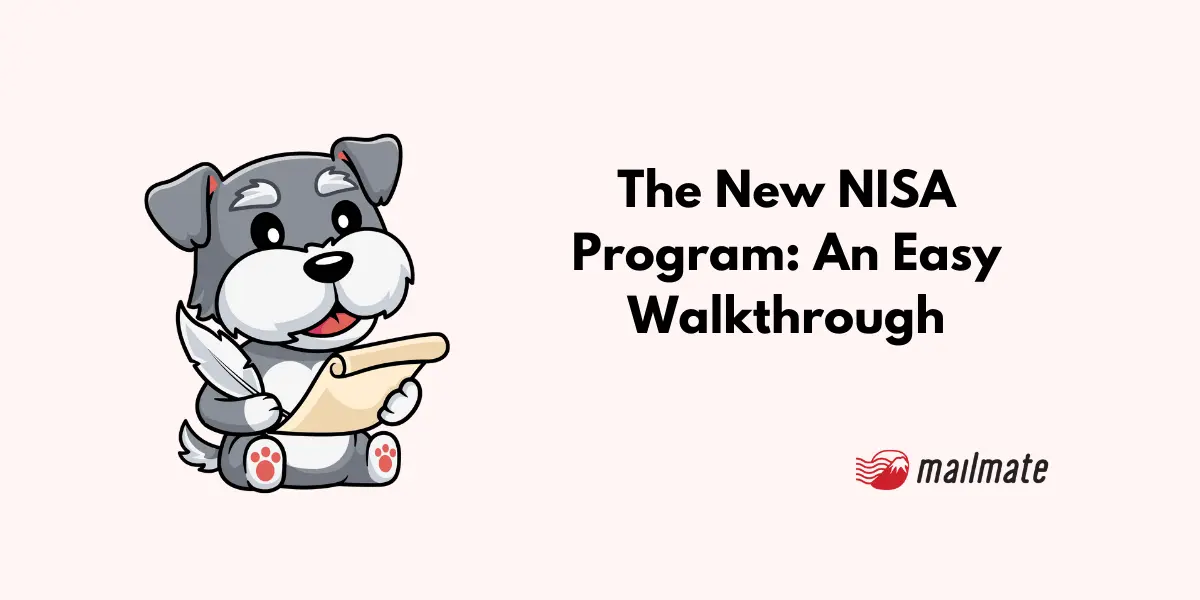The New NISA Program: An Easy Walkthrough

NISA (Nippon Individual Savings Account) is a tax-exempt savings account program initiated by the Japanese government in 2014 to help Japanese citizens and residents save for retirement.
While dividends from stocks are taxed at 20 percent, if you use a NISA account to purchase stocks, the dividends—up to a predetermined limit—are tax-exempt. Meaning, you don’t need to report profit during tax season.
These tax-exempt limits and the way NISA changed from January 2024, and largely, this is good news for NISA holders.
I’ve been using NISA for the past 4 years, and this change to the program has my inner accountant quite delighted and ready to max out my new accounts.
If you’ve been wondering what’s in the new NISA program and how to make use of it, this article is a decent place to start.
How the old NISA worked
In the old NISA program, two kinds of NISA accounts were available:
The first is the General NISA, which allows investment up to 1.2 million yen annually with a tax-free window of 5 years.
The second is the Tsumitate NISA, which permits investment up to 400,000 yen per year but offers a tax-free period of 20 years.
You can’t sign up for both at the same time, so you must choose one of them. The Tsumitate NISA necessitates at least two investments per year, as the name suggests. Monthly contributions to your investment savings account are usually expected, but it varies depending on your financial institution.
The new NISA guidelines
From January 2024, Tsumitate NISA will be called Tsumitate Quota, and the annual investment contribution limits will increase to 1.2 million yen from 400,000 yen.
The General NISA will be renamed to Growth Quota, and the annual contribution limit will be doubled from 1.2 million yen to 2.4 million yen.
Previously, you had to choose one account type or the other. With the new NISA, you can use both at the same time.
The total lifetime limit an individual can invest across both accounts is 18 million yen.
However, you are also now allowed to sell stocks from your NISA account and then repurchase so that you once again meet the limit of 18 million yen.
For instance, say you’ve maxed out your 18 million yen lifetime limit in your NISA account. You have an upcoming home renovation project, and you’ve decided to withdraw 5 million yen, reducing your NISA total to 13 million yen. In that case, you can top your NISA accounts back up until you reach the 18 million yen lifetime limit once again.
Additionally, the tax exemption period has changed from 5 years for the General Nisa and 20 years for the Tsumitate Nisa to being forever tax exempt in both the Tsumitate Quota and Growth Quota.
In other words, there is no limit to the tax exemption period for both quotas of the new NISA.
What are the main points of difference between the new NISA and the old NISA?
|
OLD NISA |
NEW NISA |
Choice of Quota |
You could only choose one of the 2 different NISA accounts. |
You can take advantage of two different NISA accounts. |
Tax-Free Period |
Set limit for tax-free profit (Tsumitate NISA: 20 years, General NISA: 5 years). |
No limit to the tax-free period. |
Investment Limits |
Tsumitate NISA: ¥8 million (¥400,000/year for 20 years), General NISA: ¥6 million (¥1.2 million/year for 5 years). |
Combined limit for both quotas is ¥18 million (¥12 million for the Growth NISA). |
Recycling Limits |
You cannot recycle your limit. |
After selling your assets, the limit can be recycled. |
What can we buy in the new NISA program?
Under the new Tsumitate Quota, the stocks and assets you can buy are pretty much the same as the old Tsumitate NISA.
The government selects the options and the eligible investment trusts are those that invest in balanced-type (asset-mixed) stocks.
The options are predominantly index funds. The current count shows 191 index funds that track specified indices, 27 other investment trusts aside from index funds that track specified indices, and 7 ETFs.
Under the new Growth Quota, individuals can purchase similar products as the traditional general NISA, including listed stocks (domestic and foreign, ETFs and REITs) and public offering investment trusts. However, certain products previously purchasable under the general NISA will no longer be available under the growth investment quota. Specifically, this pertains to stocks of companies already scheduled for delisting or those with a potential risk of delisting.
Also, for investment trusts, the following additional exclusion criteria will apply:
Trust periods of less than 20 years.
Those utilizing high-leverage derivatives (financial derivatives) for purposes other than specific objectives.
Monthly distribution types.
Additional conditions are in place here compared to eligible products in the old general NISA.
Furthermore, investment trusts tied to trending themes like Digital Transformation (DX), Artificial Intelligence (AI), Blockchain, and other engaging topics tend to have shorter trust durations, making many ineligible. NISA aims to support individual asset formation. Consequently, with the move towards permanence, the growth investment framework will also enjoy tax incentives but be limited to products more conducive to asset formation.
How much can we invest per month/per year for Tsumitate Quota?
NISA users can invest a total of 1.2 million yen per year in the new Tsumitate Quota account and a suggested amount of 100,000 yen per month.
Under the new NISA program, there is a set upper limit on the amount you can invest within one year. However, aside from depositing at least twice a year, there is no fixed minimum amount for regularly investing in your Tsumitate Quota account.
If you so desire, you can use your Tsumitate Quota to completely max out your 18 million yen NISA allotment, which you can’t do with the Growth Quota account.
How much can we invest per month/per year for Growth Quota?
NISA users can invest a total of 2.4 million yen annually, 200,000 yen per month.
The maximum you can invest in a Growth Quota account is up to 12 million yen (anything that exceeds 12 million yen will not fall under the tax benefits of this program).
How to prepare for the new NISA program?
For those who currently don’t have a NISA account, choose a financial institution that provides NISA accounts, and start the application process.
For those who already have either a General NISA or a Tsumitate NISA account, good news—your financial institution will automatically create your new NISA account for you, starting January 1, 2024. So sit tight, and perhaps free up some of your cash to max out your yearly allowable limit (3.6 million yen per year).
If an individual opens a NISA account and then moves abroad, can they still invest in their NISA account?
if you're living abroad you cannot use NISA. If you move abroad, your assets will be moved into a taxed account and it cannot be moved back into a NISA account.
However, there's a grace period for those who must move abroad (to any country except the US) due to a company assignment.
While you cannot contribute to your account (invest/buy more stocks) while you're abroad, you can freeze your NISA account for up to 5 years, and prevent your assets being deposited to a taxed account.
To do this, you must send in a notice before your move abroad and after your return. The forms you need to fill out will vary by stock brokerage companies and banks.
When moving to America, the grace period is even shorter, and the way to count it is more complex. The period is either 183 consecutive days in the States, or the total days of the following:
Days spent in the States the year one left the country.
One-third of the days spent in the States the year before that.
One-sixth of the days were spent in the States, yet another year before that.
Frequently asked questions
When does the new NISA program start?
The new NISA program starts on January 1, 2024.
What does the new NISA program contain?
The new NISA program contains major expansions to the current NISA program. For example, the investment limits per account (General NISA and Tsumitate NISA) are significantly increased and tax-free investment duration restrictions are lifted completely, with no limit imposed on the tax-free period.
Who can use the new NISA program?
Anyone residing in Japan who is 18 years and older can use the new NISA program.
What happens to the stocks in the old General NISA account?
The old general NISA assets cannot be rolled over to the new NISA. Your old general NISA assets can be transferred to a taxable account at market value once the 5-year tax-free period is up. Or, as in the past, you can still sell your assets as needed.
What happens to the stocks in the old Tsumitate Nisa account?
Assets in your old Tsumitate NISA account cannot be rolled over to the new NISA. The assets in your account will continue to be tax-exempt until the 20-year period has passed. After which you can transfer them to a taxable account or sell them off.
What happens to junior NISA accounts?
The junior NISA program will be discontinued in 2023. From 2024, there will be no program where those under 18 can invest tax-free. For investments made under the current Junior NISA, the assets will be automatically transferred to a continued management account after the tax-free period (5 years) ends. It's possible to hold these investments without taxation until the child reaches 18. An important point to remember is that the junior NISA account cannot be transferred to the new NISA program. If you are currently utilizing the existing NISA and there is still a substantial period left for tax-free investment, it might be a prudent choice to hold onto your investments without rushing to sell. Keeping your investments intact until the tax-free period is closer to expiration seems like a favorable option.
Resources
New NISA as a versatile asset builder, Fidelity International
大改正でどう変わる? 新NISA 徹底活用術
Spending too long figuring out your Japanese mail?
Virtual mail + translation services start at 3800 per month. 30-day money-back guarantee.

